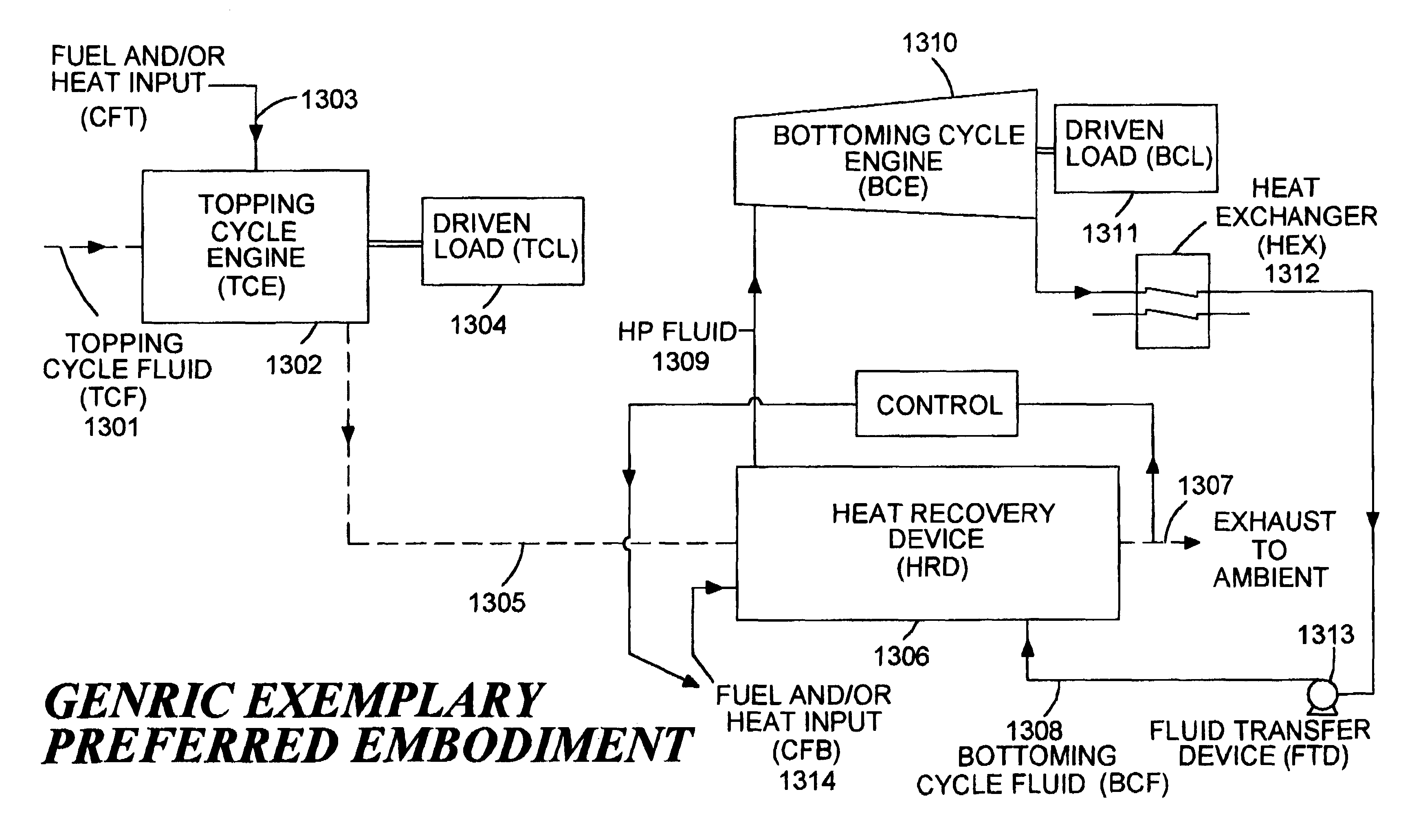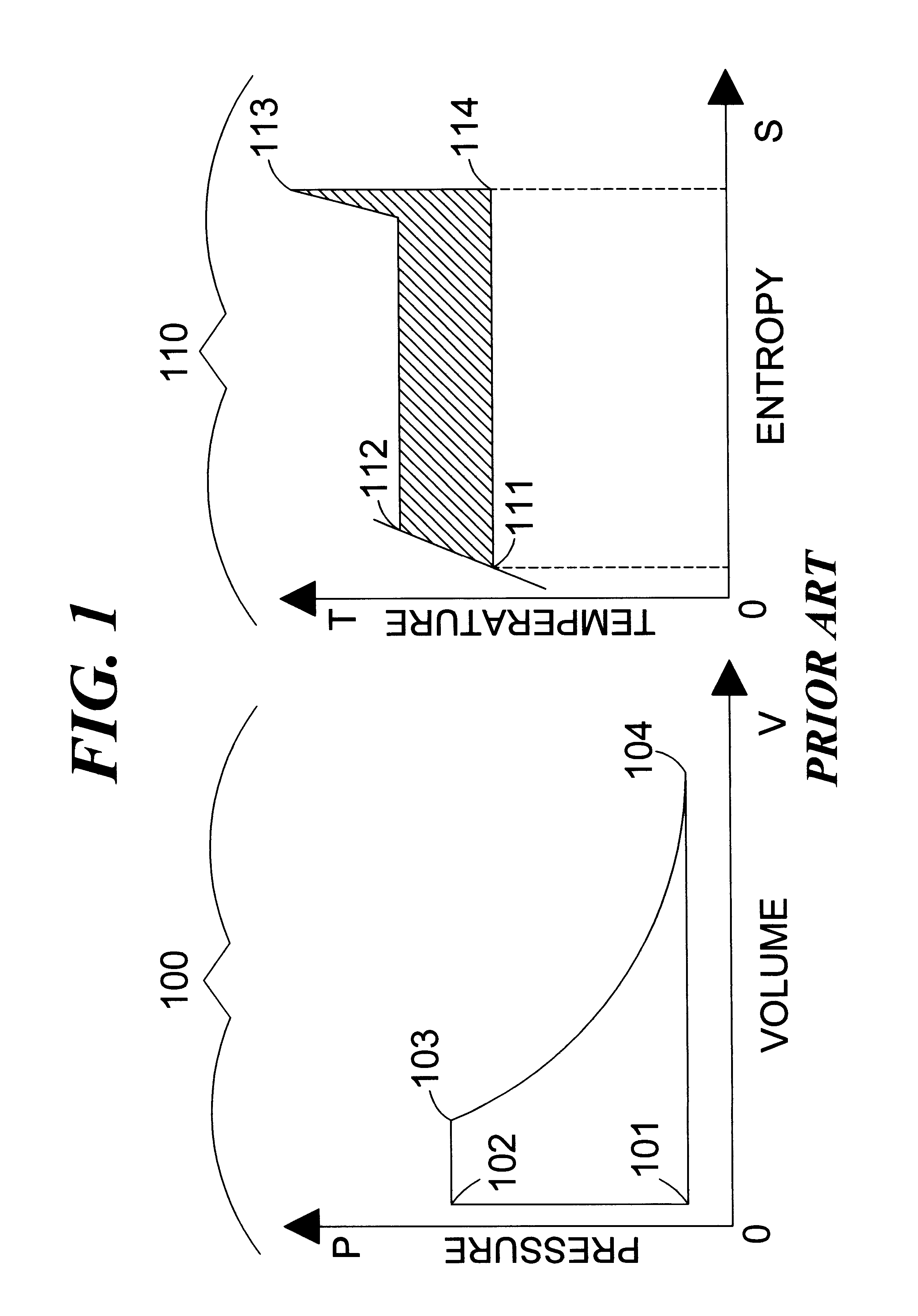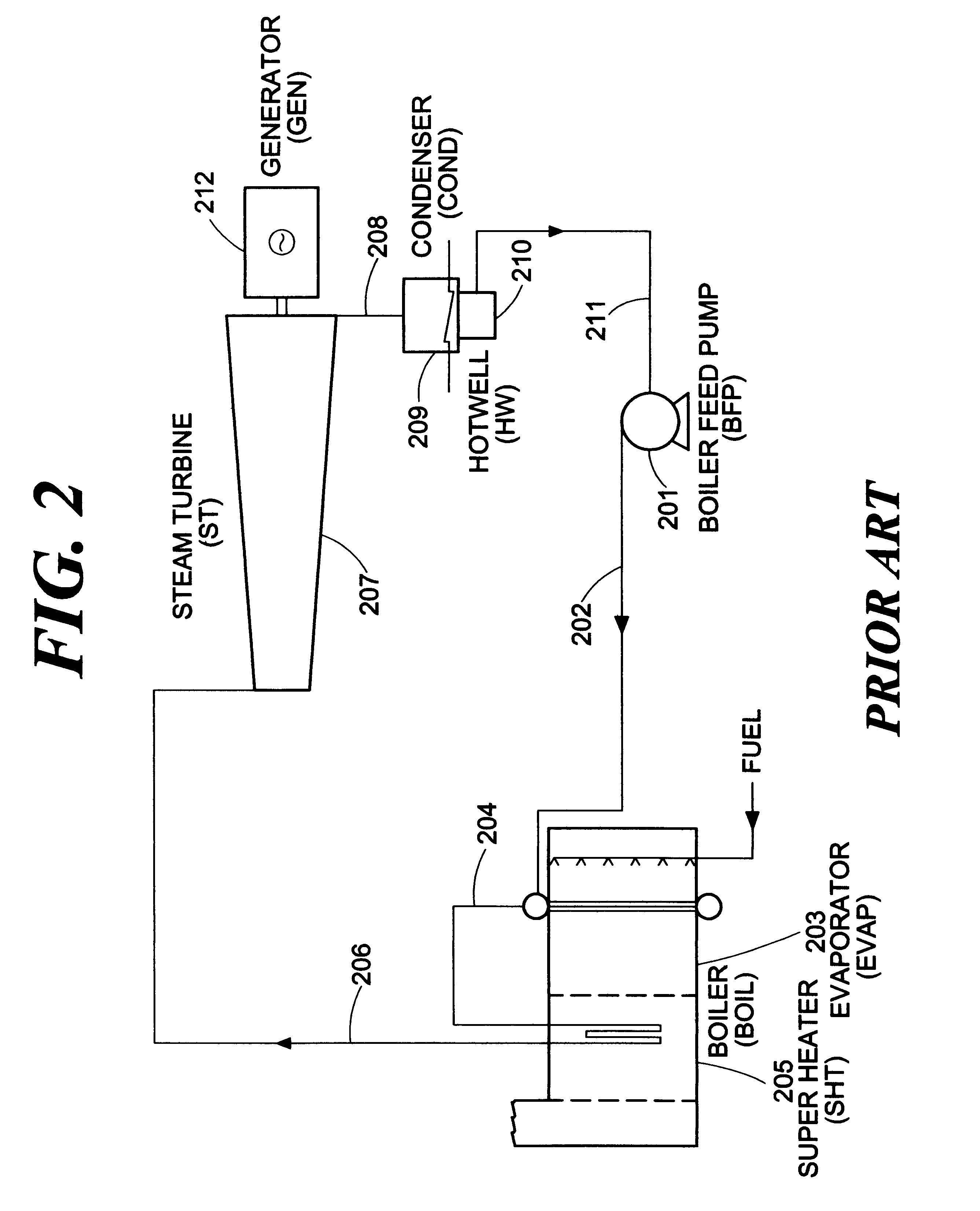However, there are limits that are imposed in these designs.
These stresses impose limits on the manufacturer's ability to produce this equipment, or economic limitations on the feasibility of producing this equipment.
In addition, above 3206 psia, steam no longer can coexist as both water and steam.
These HRSGs are typically very large and heavy pieces of equipment with literally miles of tubes inside.
Therefore, conventional steam fed feedwater heaters are not typically employed in combined cycle applications.
1. Steam cycle efficiencies are much lower than those of conventional
steam power plants.
2. Multiple
evaporator sections are required to maximize heat
recovery. This results in increased equipment and maintenance costs.
3. Multiple
evaporator sections require the plant operators and control systems to monitor and control all boiler (
evaporator) drum levels.
4. The HRSGs with the multiple sections are very large, require large amounts of infrastructure building volume, large amounts of floor space, and large foundations to support the weight of the HRSG.
5. The HRSGs are expensive (approximately $10 million for a HRSG that recovers
exhaust gas heat from one GE Frame 7 GT).
6. Maintenance increases with the number of components, evaporator sections, controls, and other devices.
7. Low-pressure steam (steam other than the highest pressure steam) has much less ability to produce power in the ST than higher pressure steam.
8. Partial load,
off design operation, and other conditions besides the design conditions typically have reduced heat
recovery and lower cycle efficiencies.
9. Increased amounts of tubing in the HRSG to enhance heat recovery add flow restriction to the exhaust gases from the GT and this increased
back pressure decreases GT output and efficiency.
Gas
turbine exhaust temperatures are not sufficient to produce some of the elevated steam conditions now used in advanced steam cycles 600.degree. C. which is equivalent to 1112.degree. F.
Balancing problems in the reheat lines with multiple GTs (typically three or more) make it difficult to utilize large STs in combined cycle power plants in the prior art.
Another
disadvantage of the combined cycle application is partial load (part load) operation.
Part load operation reduces the efficiency of the GT, thus reducing the efficiency of the entire combined cycle plant. FIG. 7 illustrates a typical curve for a large modern GT with inlet guide vanes (IGVs) to modulate inlet
airflow.
For GTs without IGVs, this decay in performance would be even more pronounced.
Note that providing this increase in part load efficiency occurs as a result of higher equipment costs.
The prior art has yet to solve the efficiency problem without the addition of more equipment that increases the overall power plant costs.
Therefore, supplementary firing of the HRSG is considered by the manufacturers to be a means to obtain more output, but with a penalty on efficiency.
No technique has been shown in the prior art to eliminate this heat rate penalty associated with supplemental firing.
However, operation at these high levels of ST / GT output are typically short in duration to meet peak power demands, and long term operation at these ratios is not economical.
Therefore, conventional combined cycle power plants that are designed with ST / GT ratios approaching unity do not operate predominantly as
Rankine cycle power plants, but do so only to satisfy temporary peak plant loads, and do so with a significant efficiency penalty at all operating conditions.
Therefore, the GT is susceptible to performance decay if the compressor does not maintain optimum efficiency.
Therefore, it can be readily seen that small decreases in efficiency for the GT compressor lead to large decreases in efficiency and output for a GT.
This efficiency decay is largely a result of worn clearances in the compressor and
erosion of the
compressor blade tips.
However, this is a costly and
time consuming repair, and would probably only be done at major inspections, which are scheduled approximately every four years for modern GTs.
Therefore, plant owners and operators will need to plan on this performance decay between major overhauls of the GTs.
However, with
gas turbines being
production line items, and combined cycles being primarily gas
turbine based power plants, to achieve the highest efficiencies and best
capital cost, a utility and / or power developer can no longer specify just their plant output, but must find the best fit for their needs from the available combined cycle offerings from the various manufacturers.
This implies that in certain circumstances the equipment complement for a given power plant installation will not be optimal because of constraints placed on plant equipment configurations by the current state of the art.
Next to fuel costs, the largest cost for a combined cycle plant is typically debt service.
One dilemma that faces power plant owners and utilities is the proper selection of power plant capacity.
Selecting a plant that is too small results in power shortages, brownouts, and / or the need to purchase expensive power from other producers.
Selecting a plant that is too large results in operation at lower efficiency during part load and increased
capital cost per kWh produced.
In many situations the problem faced by power plant developers is the need to provide for peak power needs and temporary demand loading.
Typically in the summer months during peak hours on the hottest days is the most challenging time for power producers to meet the
system load.
For example, in the early summer of 1999, power shortages in the Northeast United States have caused concern for the system's ability to meet peak power demands.
However, even much greater capacity costs have been incurred, as reported in POWER
MAGAZINE, (ISSN 0032-5929, March / April 1999, page 14): "Reserve margins are down nationwide from 27% in 1992 to 12% in 1998, according to Edison Electric Institute, Washington, DC, because deregulation uncertainty has caused capacity additions to stall.
However, providing peak power will not be lucrative if the power plant owners have to pay for this capacity, pay the debt service, and yet make revenue on this extra capacity only during a few days of the year.
From this graphic it can be surmised that it would never be profitable to design a power plant to peak loading conditions, as they occur less than 10% of the time.
One significant problem with the prior art is that the plant capacity is in general a relatively fixed and
narrow range of power generation operation.
There are several major problems with this mode of providing for peak power by rerouting remotely generated power plant capacity.
First, there exist losses associated with transmission of power from remote sites to the place where the electrical power is being demanded.
For example, a hot summer day in New York City may require diversion of power from Canada or the western United States, resulting in significant line losses during transmission.
Second, there is a reliability drawback in
purchasing power from distant parts of the grid during periods of
peak load.
What can happen is that small failures in remote parts of the grid can
cascade throughout the grid to either cause additional equipment failures or cause
instability in the
grid voltage.
Thus, relatively insignificant events in remote parts of the country can
cascade throughout the electrical grid and result in serious electrical failures in major metropolitan areas.
It is significant to note that the prior art limitations on plant output during
peak load generally preclude local generation of the required peak
power demand.
This forces traditional power plants to purchase power from
remote power plants at a substantial (10.times. to 250.times.) price penalty.
As the plant size grows, the amount of equipment increases, and as the complexity of the equipment increases, O&M costs also increase.
In the quest for higher efficiency, more elaborate and expensive technology is being utilized in the
gas turbines.
The maintenance costs associated with exotic
new materials, intricate blades, and complex hardware is projected to be significantly more expensive than the slightly less efficient, proven gas
turbine hardware and associated plant designs.
This constitutes inventory that has high costs in terms of both unused capital and taxes.
However, if the power plants are not located in close proximity to major
natural gas pipelines, the lower pressure
natural gas may have to be compressed to a sufficient pressure to be used in the GT.
This need for higher pressure
natural gas requires expensive natural gas compressors that are critical service items (the plant cannot operate without them).
These natural gas compressors require frequent maintenance and also consume parasitic power (the power to run the compressors reduces the net power available from the power plant to the grid).
These systems will all add greatly to the installed cost and O&M costs.
In addition, to date, boiler tubes, HRSGs and STs have not demonstrated long term reliable operation at elevated temperatures above 1150.degree. F., and HRSGs with diverters and natural gas reformers are as yet unproven in the marketplace.
GT engines consume large quantities of air.
This adds to the O&M costs and increases plant
downtime (time when the plant is out of service and unavailable to produce power).
In addition, the air consumed by the GT is discharged to the HRSG and then exhausted to
atmosphere.
This represents an efficiency loss as the HRSG exhaust temperature is typically about 180.degree. F.
In addition, this
airflow serves to heat the
atmosphere and contribute to local air quality problems.
Combined cycle power plants are very clean producers of power compared to other conventional methods, but are typically plagued by one criteria
pollutant, nitrous oxides (
NOX).
ut. However, at partial load, GT
NOX emissions are typically increa
tion. This increases O&M costs, and can be significant to the point where, at the
plant design stage, the desired GTs cannot be used due to high emission levels at part load opera
mption. GTs require large amounts of air, and the more air that is consumed, the more potential there is for em
This blowdown must be discharged into rivers, streams, etc. and as such requires water permits that may be difficult and
time consuming to obtain from regulatory authorities.
None of these patents, however, provide control of
heat transfer in the HRSG.
This method, however, does not provide comprehensive control, but only a means for recovering low temperature
waste heat.
None of the aforementioned patents has devised a method to control the
exhaust gas temperature of the HRSG to its optimum temperature
For large central power plants, this factor equates to significant added fuel costs.
In addition, operation at part load on the GT typically increases the emission levels for the most difficult criteria
pollutant,
NOX.
This change in flow upsets the
heat transfer in the HRSG since this device is constructed with fixed heat exchange surface area.
This phenomenon, as well as reduced GT efficiency, contributes to poorer
overall efficiency at part load operation.
If part load operation changes temperatures in the HRSG significantly, this could lead to ineffective operation of the SCR.
However, due to mechanical limitations (
centrifugal force), once the largest available blade volumetric limits are reached, more sections and more blades must be added to the exhaust end of the ST to accommodate this flow.
This adds to the installed cost and increases the real estate requirements of the ST.
Overall, this ST arrangement is less efficient than conventional steam plant STs since the HP and IP sections have low volumetric flows.
However, available real estate for a large combined cycle power plant may be difficult and expense to attain in these areas.
The drawback is that the site may lack the necessary real estate for a combined cycle repowering project.
Public acceptance is becoming increasing difficult for many utility power plant projects.
Factors such as
noise, traffic increase, unsightliness,
pollution,
hazardous waste concerns, and others contribute to public disapproval of power plants in close proximity to populated areas.
No attention is currently being given to the issue of whether plants may be redesigned to consider the ancillary issues associated with the public acceptance of the plants themselves.
Since the combined cycles in the prior art are primarily GT based, their efficiency levels are very susceptible to GT performance decay, a phenomenon in which the efficiency of the GT degrades substantially (2% to 6%) within only a year or two of operation.
This can be a significant factor in the cost of fuel as the overall combined
cycle efficiency also degrades as the GT performance decays.
 Login to View More
Login to View More  Login to View More
Login to View More 


